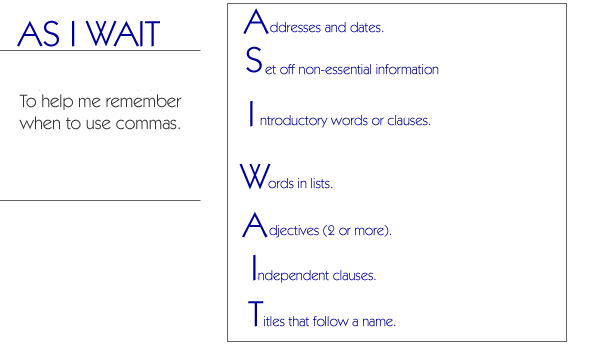A
ddresses and dates.
- Addresses need commas between the city and the state (e.g.,
Richmond, Virginia).
- Addresses need commas between the city and the country (e.g.,
London, England).
- Dates need commas between the day and the year (e.g., February
14, 2025).
|

|
S
et off non-essential information.
- Commas are needed to set off non-essential
information in a sentence.
- Non-essential information is not of
importance to the sentence. You can omit this information and
the sentence will still have the same meaning (e.g., The ice
sculpture, however, melted before the party began.).
|
I
ntroductory words or clauses.
- Use a comma to separate an introductory
clause from the rest of the sentence. A clause is not a complete
sentence and cannot stand alone. The remainder of the sentence
is complete and can stand alone (e.g., After waiting in line
for hours, we finally got to see the movie.).
- Use a comma to separate an introductory
word at the beginning of the sentence from the rest of the sentence
(e.g., Consequently, the war was lost.).
|
W ords
in lists.
- Use a comma to separate lists of words which
have three or more items (e.g., Please bring your notebook,
textbook, and pencil to class.).
|
A
djectives (two or more) for
the same noun.
- Use a comma to separate adjectives that describe
the same noun (e.g., She likes pretty, frilly dresses.).
|
I
ndependent clauses with coordinating
conjunctions.
- An independent clause contains a noun
and verb and can stand alone as a complete sentence.
- Coordinating conjunctions are words
that separate the two independent clauses (e.g., and, but,
or, for, nor, so). (The fire alarm went off, but there was
no fire).
|
T
itles which follow a name.
- Titles are abbreviations for degrees that people have (e.g.,
Joseph Wilson, M.D.) or titles involving people who have the
same names (e.g., Tyrone Johnson, Jr. vs. Tyrone Johnson, III).
|
|



